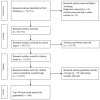Research Hotspots in Psoriasis: A Bibliometric Study of the Top 100 Most Cited Articles
- PMID: 37444683
- PMCID: PMC10340654
- DOI: 10.3390/healthcare11131849
Research Hotspots in Psoriasis: A Bibliometric Study of the Top 100 Most Cited Articles
Abstract
(1) Introduction: Psoriasis is a chronic, immune-mediated disease that negatively impacts patients' quality of life and predisposes them to cardiovascular or metabolic diseases. This paper aims to summarize the knowledge structure and future directions in psoriasis research by means of bibliometrics. (2) Material and methods: The Thomson Reuters Web of Science database was interrogated using preestablished keywords. A list of the top 100 most cited articles focusing solely on psoriasis was compiled and analyzed. VOSviewer software was used to assess and visualize collaboration networks, citation, co-citation and co-wording analysis, and bibliographic coupling. (3) Results: The articles were written by 902 authors from 20 countries and were published in 31 journals. The United States was at the forefront of this field. Griffiths, CEM had the most citations, while the most prolific institution was Rockefeller University, New York City. Pathogenesis, especially key-pathogenic factors, immune pathways, and epidemiology were the most discussed topics. Work published in the last decade focused on the use of biologics. Keywords such as "quality of life", "efficacy", and "necrosis-factor alpha" have been widely used. (4) Conclusion: Research interest regarding psoriasis is high, leading to the rapid development of this field. Treatment modalities, especially novel-targeted therapies, immune pathways, and an integrative approach to such cases are receiving great interest and represent research hotspots in the future.
Keywords: bibliometry; citation impact; immunopathogenesis; psoriasis; therapy.
Conflict of interest statement
The authors declare no conflict of interest.
Figures










References
-
- WHO Organization . Global Report on Psoriasis. World Health Organization; Geneva, Switzerland: 2016.
-
- Damiani G., Bragazzi N.L., Karimkhani Aksut C., Wu D., Alicandro G., McGonagle D., Guo C., Dellavalle R., Grada A., Wong P., et al. The global, regional, and national burden of psoriasis: Results and insights from the global burden of disease 2019 Study. Front. Med. 2021;8:743180. doi: 10.3389/fmed.2021.743180. - DOI - PMC - PubMed
Publication types
LinkOut - more resources
Full Text Sources

